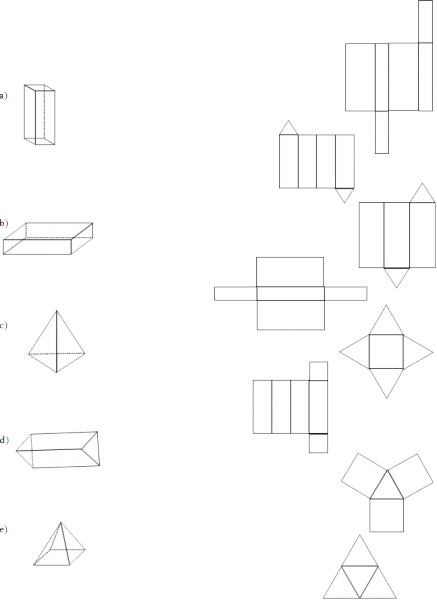Matching nets
Each shape has only one net. Draw a line to match the net that could make the shape.
There will be 3 nets left over.

| Y8 (10/2010) | ||
|
a)
|
|
very easy 1 easy easy easy easy |
| a)-e) |
All 5 correct (48.3%)2 4 or more correct (67.2%)2 3 or more correct (75.9%)3 |
moderate easy easy |
Based on a representative sample of 174 Y8 students.
NOTE:
- There are only modest differences in difficulty levels between the five nets. While the first one is rated "very easy", it is only just above the 80% threshold.
- Students who got five nets correct generally obtained higher scores in our sample than those getting four.
- Students who got four nets correct generally obtained higher scores in our sample than those getting three.
This resource tests students' ability to identify nets for prisms and other simple solids.
- Shapes a) and b) are rectangular prisms, and d) is a triangular prism.
- Shapes c) and e) are pyramids. Shape c) is a triangular pyramid. If all four faces are the same it is called a tetrahedron. Shape e) is a square pyramid.
The three prism questions are of approximately the same level of difficulty as the pyramids.
| Common response | Likely misconception | |
|
a) b) |
1st shape 4th shape |
Gives a net for another rectangular prism These students select a net from the same family of shapes. The 4th shape does not fold to a rectangular prism as the sides of the left- and right-hand flaps are longer than the side-length of the top and bottom flaps. |
|
c) e) |
5th shape 8th shape |
Gives net for another pyramid These students select a net from the same family of shapes. |
| c) or e) | 7th shape |
Gives net for a triangular prism These students select a net that includes a triangular face without realising the net folds to make a triangular prism with no top. |
| a) – e) | Other errors | Does not visualise more complex nets |
NOTE: Students making the first three errors(i.e., all but the last row) had far lower mean abilities than those choosing the correct options. However, their mean ability was significantly higher than those choosing other incorrect options. Those who made other errors had consistently lower overall scores in our sample.
Gives a net for another rectangular prism OR Gives shape for another pyramid
These students should be encouraged to subdivide the nets into the three classes of shapes they fold to (rectangular prism, triangular prism, and pyramid). They should easily select the correct class of shapes, but need to look more critically at what shape each net makes.
Gives net for a triangular prism
These students should attempt to visualise the shape the 7th net makes, and describe it to a peer. While it does have one triangular face, they need to see that it folds to make a triangular pyramid. They may need to cut it out if they cannot visualise this.
Does not visualise more complex nets
For students who match fewer than three shapes, or who choose from wrong classes of nets (e.g., rectangular prisms, triangular prisms, and pyramids) could get together in small groups. Ask them to sort the shapes into different classes depending on the type of shape the net will make. Get them to justify how each net can fold, and classify these into the same three classes. For groups who cannot reach a (correct) consensus, get them to talk with a group who has. If this fails, get them to work with concrete materials by cutting out and trying to fold the shapes to make prisms (you may wish to enlarge the nets using a photocopier).
Peer assessment
This resource presents an excellent opportunity for students to assess each others' responses. Those who have mastery can demonstrate this as they assess other students' responses. Those who can visualise how the nets fold can assess students who are still learning to visualise.

